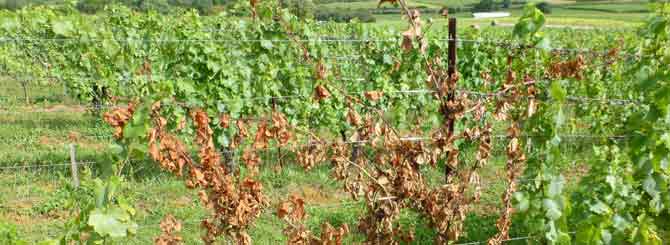Fatal Wood Diseases Affect 12 Percent of French Vineyards
Date£º
2014-10-15 09:10 Source£º
winesearcher Author:
Wink Lorch Translator:
Esca and other wood-borne fungal diseases now cause the death of 5 to 7 percent of vines annually in France.

Esca kills individual vines in otherwise healthy vineyards
Fatal wood-borne fungal diseases affecting vines have become a national issue in France, it was announced last week, after research showed that almost one-eighth of the country's vines have fallen prey to the diseases.
Working alongside the French Vine Institute (IFV), France's Assembly of Chambers of Agriculture (APCA) will provide greater support to growers trying to find solutions to the problem.
Jean-Pierre Van Ryskensvelder, director of the IFV, said: "Wood diseases are a national crisis. They are responsible for 12 percent of the French vineyard area being non-productive. This represents nearly 100,000 hectares (250,000 acres) of vineyards giving an estimated loss of 1 billion euros."
The president of APCA, Guy Vasseur added: "In the past three years, we have noticed the mortality of vines increase. Every year, between 5 and 7 percent of vines die."
There are three main wood-borne fungal diseases affecting the vine ¨C esca, black dead arm and eutypa dieback ¨C which are neither new, nor are they exclusive to the French vineyards, being present in Mediterranean countries and in North American vineyards.
Whereas eutypa is controlled relatively successfully by rigorous disposal of dead vines and protecting the pruning wounds with a fungicide, there has been no effective cure available for black dead arm or esca since the banning of the fungicide sodium arsenite in 2001.
Esca, which is becoming a particular problem in many French wine regions, causes sudden death of an individual vine in late summer, usually after an imperceptible gradual weakening over several years. It affects vines in the prime of their life, usually between 10 and 25 years old, when they are most productive. Although growers try to replant to fill the gaps each year, it is a costly and time-consuming activity.
Certain grape varieties appear to be more prone to wood diseases than others and the IFV intends to work closely with INRA (the national agricultural research institute) and with French universities to identify which grape varieties are the most resistant.
These diseases are taken so seriously that some growers are calling it the 21st Century version of phylloxera, the vine disease that devastated vineyards in France and around the world at the end of the 19th Century.